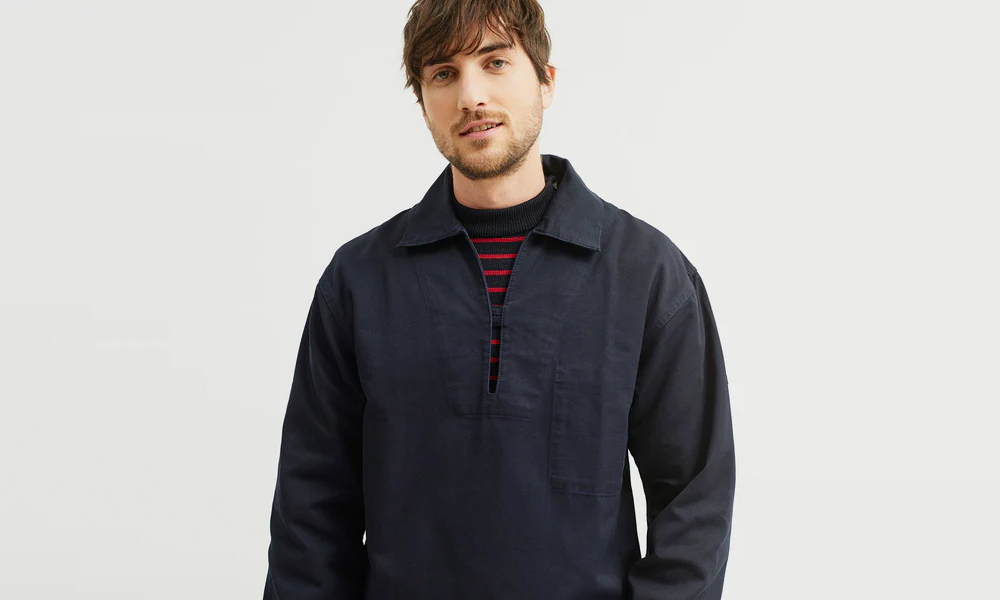Layering is a key component of putting an outfit together — especially in transitional seasons. While you can always grab your denim jacket or your comfortable sweater, there is always room to expand your sartorial perspective into less well-worn territory.
Take, for example, the fisherman’s smock, also known in French as a vareuse (the French word for loose coats or jackets). Lesser known outside of traditional seafaring communities, the fisherman’s smock has a history that celebrates the simplicity of a well-constructed garment, while also giving you a bit of a Gallic je nais sais quoi.
While variations exist across Scandinavia and the British Isles, the most popular design of the fisherman’s smock comes from the Brittany region of France. Built to withstand both the harsh environments at sea and in France’s coastal peninsula communities, these smocks are well-constructed, easy to throw on, and perfect for layering.
History of the Fisherman’s Smock
Like many good garments, the fisherman’s smock’s origins falls into the workwear category of clothing. It was originally designed for fishermen in northern Europe, and later used by the shipping trade in general to keep people at sea warm during their excursions.
The design of the smock is indicative of coastal communities’ resourcefulness as well as the lifestyle of the fishermen themselves. The early smocks worn by fishermen were made from durable materials to stay as windproof and waterproof as possible. The loose fit allowed for ventilation and layering, while the wide sleeves that cut just a bit short on the arm were designed for mobility and agility while at sea.
The fisherman’s smock played a crucial role in keeping fishermen dry and warm, protecting them from saltwater spray and wind. Over time, different regions in France developed their own variations, often featuring distinctive colors and patterns. In Brittany, for example, blue and white stripes were common, while Normandy favored red and white stripes. These variations not only served functional purposes but also acted as identifiers of a fisherman’s hometown or community. Today, there is a bit more homogenization among vareuse manufacturers, who opt for nautical colorways like navy, red, and yellow.
Today, like the Breton stripe shirt, the fisherman’s smock has become more a symbol of national pride than a workwear piece. But that’s not to say that the garment has lost all functionality. More and more people have adopted the smock as their preferred outerwear choice for various activities, including gardeners and painters (and, of course, menswear writers for Cool Material).

Fisherman’s Smock Construction
- Loose and comfortable fit: The smock is typically designed to allow for freedom of movement that you won’t find in our run-of-the-mill sweater.
- Pullover design: One of the defining characteristics of the fisherman’s smock is its pullover style. It lacks buttons or zippers, making it easy to put on and take off, even when hands are cold or wet.
- Wide neck opening: The smock often features a wide and generous neck opening, allowing for quick and effortless donning, especially when worn over other clothing. This design ensures that the smock can be pulled over the head without fuss, making it a practical garment for busy and demanding work environments. Another notable feature of a vareuse is the internal button at the opening, a holdover from the more rugged history of the garment when the wearer wouldn’t want the button exposed and liable to popping off at sea.
- Long sleeves and cuffs: To provide maximum protection from the elements, the smock typically includes long sleeves with cuffs. These sleeves can be rolled up when necessary, but are designed to keep the arms warm and dry during cold and wet conditions. The cuffs can be cinched to prevent water from entering the sleeves.
- Pockets: The smock often features generously sized pockets, typically located at the front and internally to keep things safe from the elements and out of the way.
Styling a Fisherman’s Smock
The beauty of this garment is its simplicity and its ability to integrate into your existing wardrobe with minimal thought. Because of its workwear roots, it’s going to blend easily with other workwear pieces, such as a good pair of Levi’s or Dickies.
For more advanced styling direction, you can always lean into the Breton aesthetic by layering a horizontal striped shirt underneath the smock. Pair it with white trousers or olive chinos and roll the cuffs up to keep it casual. A turtleneck or even an Oxford can be worn under a vareuse, but there shouldn’t be anything too distracting for this look.
The less you style this garment the better. Its boxy shape and lack of any excess decoration means that you should try to reduce any over styling and instead let the smock be another layer to your existing style versus letting the garment be incongruous to your wardrobe.






